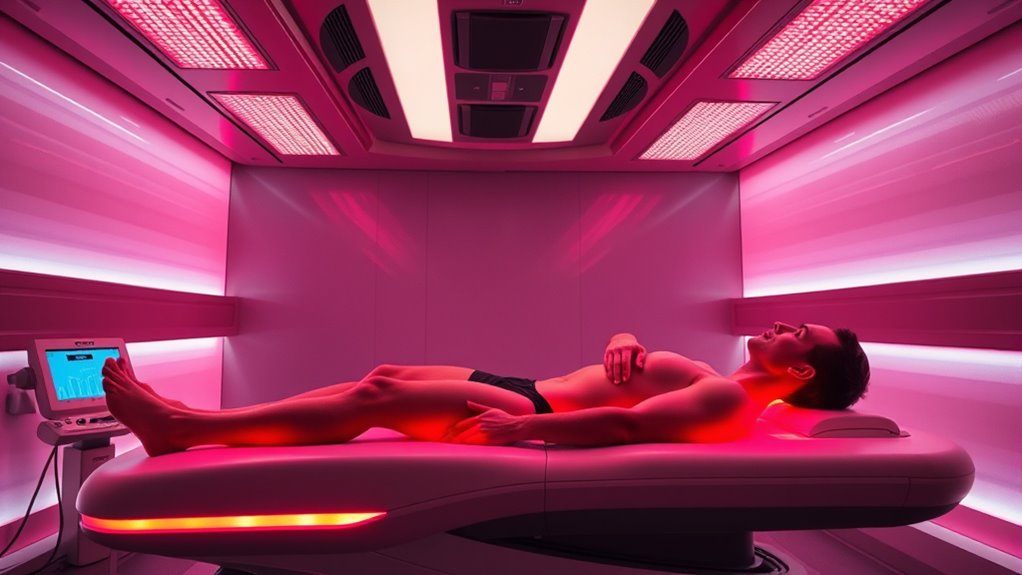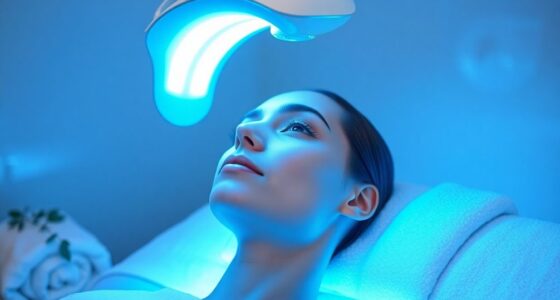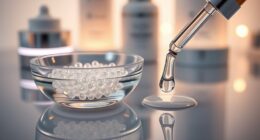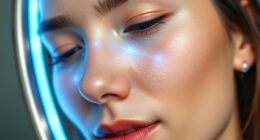Near-infrared light therapy boosts your muscle recovery and athletic performance by stimulating your cellular energy, reducing inflammation, and speeding up tissue repair. It penetrates deep into your muscles, helping mitochondria produce more ATP, which fuels your muscles and reduces soreness. This non-invasive treatment supports longer endurance, quicker recovery, and overall better performance. Keep exploring to discover how integrating this science-backed method can give you a competitive edge and enhance your training routines.
Key Takeaways
- Near-infrared light stimulates mitochondrial activity, increasing ATP production to support muscle energy and enhance recovery.
- It reduces muscle inflammation and microtears, accelerating repair and decreasing soreness after intense exercise.
- The therapy improves mitochondrial function, boosting muscle cell resilience and endurance during athletic activities.
- As a non-invasive, drug-free method, it allows for faster recovery, less fatigue, and better athletic performance.
- Portable near-infrared devices enable easy integration into training routines, supporting consistent muscle health and long-term athletic development.

Have you ever wondered how emerging technologies can boost athletic performance? One innovative approach gaining attention is near-infrared light therapy, particularly photobiomodulation therapy. This technique uses specific wavelengths of near-infrared light to stimulate cellular activity, especially within the mitochondria—the energy powerhouses of your cells. When you undergo photobiomodulation therapy, the light penetrates your skin and reaches deep into your muscles, triggering mitochondrial stimulation. This process enhances your cells’ ability to produce adenosine triphosphate (ATP), which is essential for energy production. As a result, your muscles recover faster, fatigue diminishes, and your overall performance improves.
Near-infrared light therapy boosts muscle recovery and enhances athletic performance through mitochondrial stimulation.
The core idea behind this technology is that by stimulating mitochondrial activity, you can accelerate the repair process after intense workouts. When your mitochondria are more active, they generate energy more efficiently, helping your muscles recover from microtears and inflammation caused by training. This means less downtime between sessions and a quicker return to peak performance levels. Photobiomodulation therapy doesn’t just aid recovery; it also contributes to reducing soreness and swelling, enabling you to train harder and more frequently. Athletes and trainers are increasingly adopting this technology because it offers a non-invasive, drug-free method to maximize physical readiness.
Beyond recovery, near-infrared light therapy can also enhance endurance and strength. By improving mitochondrial function, your muscle cells become more resilient and capable of sustained exertion. This boost in cellular energy translates to better stamina during competitions or long training sessions. Additionally, the therapy supports cellular regeneration and reduces oxidative stress, which can otherwise impair performance over time. When you incorporate near-infrared treatments into your training routine, you’re effectively giving your body a tool to maintain ideal cellular health, which is essential for long-term athletic development. Research also indicates that wax and dye materials used in other applications have comparable safety profiles when properly managed, underscoring the importance of understanding material safety in related health technologies.
Another advantage is the ease of use—many athletes utilize portable devices to apply near-infrared light at home or in the gym. This flexibility allows you to integrate consistent therapy sessions into your schedule, maintaining mitochondrial health without significant disruption. As research continues, the understanding of how photobiomodulation therapy influences cellular processes becomes clearer, making it an increasingly valuable addition to athletic training and recovery protocols. Embracing this technology means you’re leveraging science to push your limits, recover faster, and perform at your best.
Frequently Asked Questions
How Quickly Can Athletes See Results From Near-Infrared Therapy?
You might notice improvements in muscle soreness and injury prevention within a few sessions of near-infrared therapy. Many athletes report feeling less pain and quicker recovery after just 3 to 5 treatments. Consistent use helps speed up muscle recovery, reduce soreness, and prevent injuries, so you can get back to training faster. Keep in mind, individual results vary, but early benefits are often seen soon after starting therapy.
Are There Any Risks or Side Effects Associated With Near-Infrared Use?
The question about risks of near-infrared therapy is vital—you’re not risking a minor inconvenience, but your health! Generally, device safety is well-regulated, and side effects are rare when used properly. Long-term effects are still being studied, but most users experience safe, benefits-driven outcomes. Just follow guidelines, avoid overuse, and consult professionals to guarantee you’re harnessing near-infrared power safely and effectively.
Can Near-Infrared Therapy Replace Traditional Recovery Methods?
You might wonder if near-infrared therapy can replace traditional recovery methods. While it’s a promising alternative therapy that accelerates muscle healing and reduces soreness, it shouldn’t completely replace traditional methods like rest, nutrition, and physical therapy. Instead, consider it a complementary tool to boost your recovery process. Combining near-infrared with traditional approaches offers a more thorough strategy for optimal athletic performance and faster muscle recovery.
Is Near-Infrared Effective for All Types of Sports or Only Specific Ones?
They say, “Different strokes for different folks,” and that’s true here. Near-infrared therapy works well for many sports, but its effectiveness depends on sport-specific recovery needs and equipment customization. It’s particularly beneficial for endurance or high-impact sports, but may be less effective for sports with different demands. You should consider your sport’s unique recovery requirements before relying solely on near-infrared treatments.
What Is the Optimal Duration and Frequency for Near-Infrared Treatments?
You should focus on treatment scheduling and session duration to maximize near-infrared benefits. Typically, sessions last about 15-20 minutes, 2-3 times a week, but this can vary based on your goals and response. Listen to your body and consult a professional for personalized guidance. Consistency is key, so maintaining a regular schedule helps improve muscle recovery and athletic performance over time.
Conclusion
Imagine opening your full potential with near-infrared therapy, turning setbacks into comebacks. As you harness this powerful tool, you’re not just recovering faster—you’re rewriting what’s possible for your body. Near-infrared acts like a silent partner, amplifying your strength and resilience. So, why settle for ordinary when you can tap into the extraordinary? Embrace this innovation, and watch your athletic journey transcend limits—because the future of performance is shining brighter than ever.









